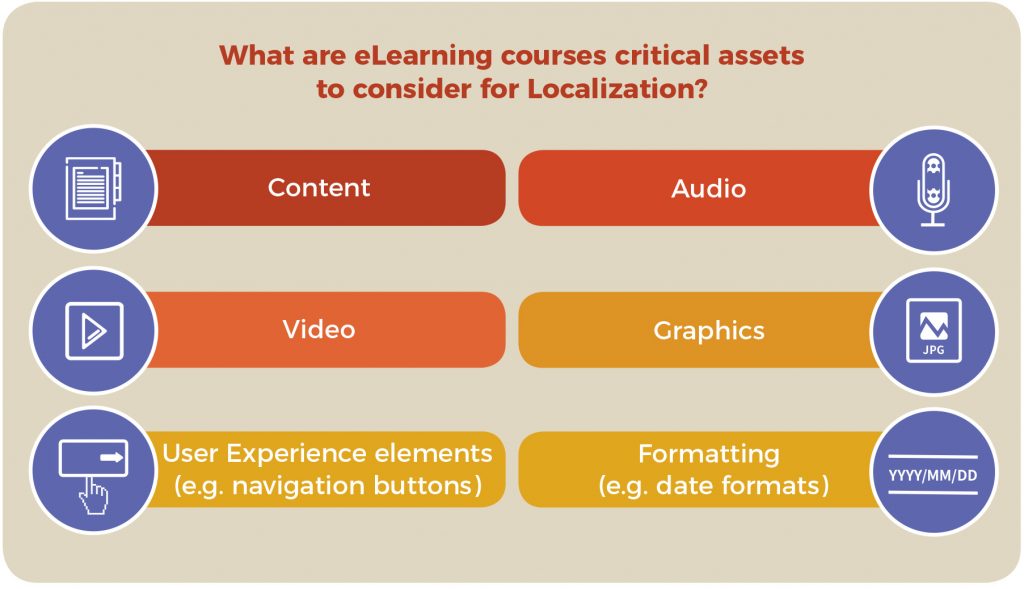More and more multinational companies are investing in eLearning, which is a cost-effective approach to training and increased employee retention compared to conventional programs. Yet multilingual eLearning has complex linguistic, technical, content development and voiceover requirements. Particularly, with the rise of distributed teams, it can be difficult to meet the team’s Learning and Development requirements due to the cross-cultural context. Guidelines and coordination for eLearning are needed to achieve cohesion and alignment of the group for a more productive distributed team with clearer objectives and knowledge.
This is the third article in our Voiceover Series. The first and second articles can be found here.
- 5 Tips to Mastering the Art of Voiceover in the Video Games
- The Importance of Explainer Video Voiceover Explained
A CLOSER LOOK AT eLEARNING
Technical considerations of diverse tools are crucial for successful localization since eLearning courses are now commonly developed on Learning Management Systems (LMS), while modifying forms and databases, standardizing date, measurement, currency formats, and other fundamentals and tools such as Adobe Captivate, Articulate Rise, Articulate Storyline, Lectora are considered as well. It may also require creating content design templates, foreign character sets, localizable assets such as slides, questionnaire, icons, navigation buttons voiceover recordings, etc.
In fact, eLearning localization considers cultural aspects and adapts both the text and visual content for the target country. The most common features that need localization are the following:

Usually eLearning courses include slides, voiceover, quiz, and interactive videos. Graphic elements can pose a problem when creating a design template for multiple target markets. For example, icons may be understood in one culture but not in another or may even have a different meaning altogether. The target markets must be understood like a native speaker would because ignoring cultural factors can cause disappointing and ineffective learning experiences, which ultimately leads to increased drop-out rates. A developer working in one cultural context must adjust to various changes in context that arise with audiences in different international locales. And the terms, examples, or phrases that lack meaning in other locales must be avoided. Likewise, the impact of geographic differences for the same language—such as for the French speaking market in Canada have a different linguistic style and vocabulary from the French speaking market in France. Other issues like the pronunciation of certain words, acronyms (MAC, it is “M” “A” “C” or “MAC”, for 1300 is it “a thousand three”, “a thousand three hundred” or it is “thirteen hundred”), or technical terms could differ across cultures as well.
GIVING ELEARNING A VOICE
The voiceover represents the content and the visual presentation complements it. A flawless script for the voiceover and slides that summarize will help learners tremendously.
1. Adjusting to the Perfect Tone
Depending on the content of the videos, consider adjusting the tone accordingly. This will not only add authentic character to the voiceovers but also keep the audience engaged. Generally, a conversational tone with a sense of professionalism is typically preferred for eLearning voiceovers. By sounding serious without seeming too instructive or formal is key.
Professional voiceover artists have extensive experience and polished narrative skills for better results that sound more professional, which can build and maintain a strong connection with the audience.
2. Types of Voiceover Narration
- Elaborative – An explanation of written summarized content in detail.
- Paraphrasing – It involves summarizing the on-screen content in spoken words so audience can go through the written content while listening to the core material simultaneously.
- Verbatim – The words on screen are repeated word for word. This can be ineffective due to unnecessary redundancy and lack of explanation.
- Descriptive – A description of the images presented on the screen is given.
Note that excessively repeating the exact words written on the screen can confuse the audience and make it difficult to grasp information. It may seem patronizing and annoy viewers by seemingly questioning their ability to read the material properly.
3. Globalize the Content
It is helpful to build standard linguistic style guidelines and terminology while using clear, concrete language. It is common to keep sentences short and avoid excessive use of commas. The active voice in the present tense is often used. And the use of analogies and metaphors is avoided. Certain cultural references, such as humor, gender-specific roles, and ethnic, geographical, or historical references that could either lose meaning or be inappropriate in another locale and culture should be revised or omitted. Likewise, more considerations are needed for references to alcohol, gender, religion, politics, the human body, or animals.
In brief, Clearly Local has created a comprehensive checklist to collect the requirements from the client and to understand the voice quality our voice talent should have especially for the tone we need, whether it is an authoritative voice or a more friendly and conversational style.
Prior to voice recording, Clearly Local Language Manager will also review the script and highlight all the words that may have different pronunciations in order to create a pronunciation guide based on our clients’ needs. Source text is reviewed to ensure that it is concise, clear and free of culture-specific examples and references, and that it does not contain misused jargon or slang. A clear, conversational, reader-friendly tone in the script can be favored. Proper international support and available localized versions that address and support international character sets, culturally correct representation of time and date, personal data, and specific business practices related to human capital management requirements in each market are provided. Avoiding slang and idiomatic language can also ensure higher clarity. Finally, all translatable components are externalized so that they can be easily identified and translated.
eLEARNING, THE EMERGING VOICE
When it comes to the eLearning industry, eLearning voiceover is often overlooked. However, they are one of the most essential elements of online courses. A relatable, professional voiceover for the on-screen content is a key to increasing user attraction, engagement, and knowledge retention. At Clearly Local, a guide for flawless, professional eLearning voiceover and localization is proven to ensure quality for both the instructor and learners.



